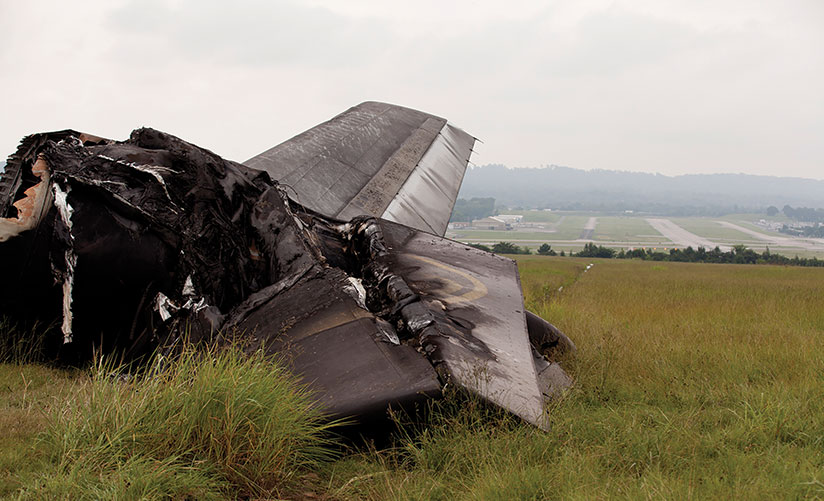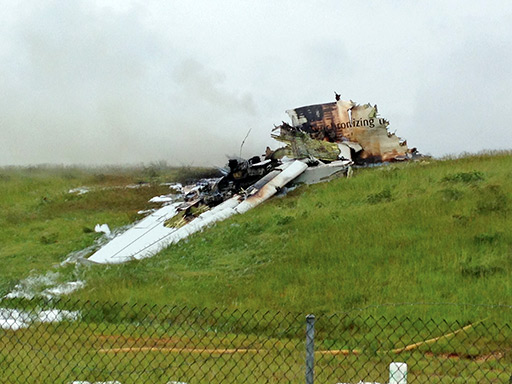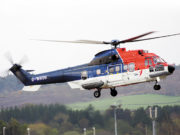
Relying on the reported weather conditions at the airport, the flight crew expected to break out of the clouds 1,000 ft above ground level (AGL) while conducting a late-night nonprecision approach. They did not realize that the bases of the clouds along the approach path were lower than those over the airport.
Concentrating on gaining sight of the runway, the pilots allowed the Airbus A300-600 freighter to descend below the minimum descent altitude for the approach. They finally caught sight of the runway about two seconds before the airplane struck the ground near Birmingham (Alabama, U.S.)–Shuttlesworth International Airport at 0447 local time on Aug. 14, 2013. Both pilots were killed, and the airplane was destroyed by the impact and subsequent fire.
In its final report, the U.S. National Transportation Safety Board (NTSB) said that the probable causes of the accident were “the flight crew’s continuation of an unstabilized approach and their failure to monitor the aircraft’s altitude during the approach.”
The NTSB determined that fatigue played a major role in the accident (see “Sooo Tired,” ASW, 11/14) and that the crew’s improper programming of the flight management system to achieve descent at a constant angle on final approach, the captain’s failure to inform the first officer when he switched from the autopilot profile mode to the vertical speed mode, and the first officer’s failure to make required altitude callouts also were contributing factors.
‘Substandard Elements’
 The A300 was being operated as UPS Flight 1354, a scheduled cargo flight to Birmingham from Louisville, Kentucky.
The A300 was being operated as UPS Flight 1354, a scheduled cargo flight to Birmingham from Louisville, Kentucky.
The captain, the pilot flying, was 58. He flew for a regional airline and for a major airline as a Boeing 727 flight engineer and first officer before being hired by UPS as a 727 flight engineer in 1990. He upgraded as a 727 first officer in 1994.
“UPS records indicate that the captain attempted to upgrade to Boeing 757 captain twice — in July 2000 and September 2002 — but voluntarily withdrew from training during classroom instruction, returning to the position of 727 first officer on both occasions,” the report said. He upgraded as an A300 first officer in 2004 and as an A300 captain in 2009.
“Although the captain reported 8,600 hours of total flight time on his most recent first-class medical application, no documentation of that time was available,” the report said. “A review of UPS records indicated that the captain had about 6,406 hours total flight time at UPS, of which 3,265 hours were in the A300.”
UPS records revealed several instances in which the captain displayed substandard performance while conducting nonprecision instrument approaches during recurrent training. “The captain’s poor performance during the accident flight was consistent with past performance deficiencies … during training,” the report said.
The first officer, 37, flew for corporate and regional aircraft operators before being hired by UPS as a 727 flight engineer in 2006. She then upgraded as a first officer in the 757, 747-400 and A300. “According to UPS records … the first officer had about 4,721 hours of total flight time, including 403 hours as second-in-command in the A300,” the report said.
Lack of Communication
Investigators determined that the flight crew likely was not aware before departing from Louisville of two critical factors relating to their arrival at Birmingham: the main runway would be closed, and a precision approach would not be available.
The report attributed this absence of awareness in part to a lack of communication between the pilots and the dispatcher at Louisville. The dispatcher did not point out salient information about the weather conditions at Birmingham or about the runway and approaches available at the airport at the estimated time of arrival. The pilots did not seek the dispatcher’s input.
The flight release paperwork provided to the flight crew included a notice to airmen (NOTAM) stating that the main runway at Birmingham — Runway 06/24, which has an instrument landing system (ILS) approach — would be closed from 0400 to 0500 for maintenance of the runway edge lights.
“Because the flight’s scheduled arrival time was 0451, only the shorter Runway 18, with a nonprecision approach, was available to the crew,” the report said. Runway 18 is 7,099 ft (2,164 m) long and has a localizer approach and a global positioning system (GPS) approach.
“The investigation could not confirm whether the flight crewmembers became aware of the NOTAM during their paperwork review,” the report said.
Moreover, the Jeppesen charts the crew was using indicated erroneously that the localizer approach was not authorized at night, and the forecast weather conditions at Birmingham indicated that the ceiling would be below the minimum descent altitude for the GPS approach.
“As a result, the flight may have had to divert to its alternate of Hartsfield–Jackson Atlanta [Georgia, U.S.] International Airport … or hold until the longer runway opened,” the report said. “However, the dispatcher did not discuss this possibility or remind the flight crew that Runway 06/24 would reopen about 0500.”
“The NTSB concludes that the dispatcher of UPS Flight 1354 should have alerted the flight crew to the limited options for arrival at [Birmingham], especially that Runway 18 was the only available runway, because doing so would have further helped the pilots … evaluate all available options.”
The dispatcher told investigators that he generally did not, and was not required to, talk with pilots. “He indicated that he typically only spoke with pilots when they initiated the conversation,” the report said.
The investigation determined that the flight crew was not aware before departing from Louisville that Runway 06 and, consequently, the ILS approach would not be available when they reached Birmingham.
A 9-minute delay of the departure, which either the captain or the dispatcher was authorized to make, would have changed the expected arrival time to coincide with the runway’s scheduled reopening time. However, neither the captain nor the dispatcher apparently considered changing the scheduled departure time.
‘It Figures’
Shortly after the A300 departed from Louisville at 0503 (0403 Birmingham time), air traffic control (ATC) cleared the crew to navigate directly to the Birmingham airport and to climb to Flight Level (FL) 280 (approximately 28,000 ft).
Nearing Birmingham, the first officer listened to the automatic terminal information service (ATIS) broadcast, which stated that the winds were calm, visibility was 10 mi (16 km), the ceilings were broken at 1,000 ft and overcast at 7,000 ft, the localizer approach to Runway 18 was in use and that Runway 06/24 was closed. (No information about when the runway was scheduled to be reopened was included in the broadcast.)
The ATIS information was based in part on meteorological observations from a routine aviation weather report (METAR) issued at 0353. Although the METAR included remarks that the ceiling varied between 600 ft and 1,300 ft AGL, the remarks were not included in the ATIS broadcast.
The report noted that although the U.S. Federal Aviation Administration (FAA) requires ATC personnel to include “pertinent remarks” in ATIS broadcasts, the agency provides limited guidance on what information is pertinent. “If the flight crewmembers had been aware of the variable ceilings reported on the 0353 METAR, they may not have expected to break out of the clouds at 1,000 ft AGL,” the report said.
After copying the ATIS information, the first officer told the captain, “They’re saying six and two-four is closed. They’re doing the localizer to one eight.”
The captain replied, “Localizer one eight, it figures.”
“I know, especially since we’re a little heavy,” the first officer said.
The report said these comments indicate that the pilots were not aware before hearing the ATIS broadcast that Runway 06/24 would be closed and that the ILS would be unavailable.
A UPS A300 check airman told investigators that although pilots receive annual training on nonprecision approaches, they rarely conduct them during line operations. “In most cases, a UPS pilot’s only opportunity to practice nonprecision approaches would likely occur once a year during recurrent training,” the report said. “An unintended consequence of the operational preference for precision approaches is that pilots have lost proficiency with the unique procedures associated with infrequently conducted nonprecision approaches.”
‘Meaningless’ Path
The localizer approach to Runway 18 at Birmingham includes an initial approach fix called “COLIG”; a final approach fix, “BASKN”; and a step-down fix, “IMTOY,” between the final approach fix and the missed approach point. The minimum crossing altitudes are 2,300 ft at BASKN and 1,380 ft at IMTOY; and the minimum descent altitude (MDA) is 1,200 ft (Figure 1).
Figure 1 — A300 Flight Path
DA/MDA = decision altitude/minimum descent altitude; KBHM = Birmingham-Shuttlesworth International Airport
Source: Adapted from U.S. National Transportation Safety Board report by Jennifer Moore
Because consecutive descents and level-offs are required after BASKN and after IMTOY, this is considered a step-down, or “dive and drive” approach. To illustrate the drawbacks of such approaches, the report cited FAA Advisory Circular 120-108, Continuous Descent Final Approach, which says, “Stepdowns flown without a constant descent will require multiple thrust, pitch and altitude adjustments inside the final approach fix (FAF). These adjustments increase pilot workload and potential errors during a critical phase of flight.”
To avoid this, the pilots planned and briefed for a “profile approach,” also called a “continuous descent final approach,” which would enable descent at a constant angle (3.28 degrees in this case, as shown on the approach chart) after the FAF.
To prepare for the profile approach, the first officer attempted to program the flight management computer (FMC) to generate the 3.28-degree glide path from 2,300 ft at the final approach fix to the MDA, 1,200 ft. Investigators found, however, that she did not program the FMC correctly for the profile approach: The waypoints for the en route portion of the flight were not cleared from the flight plan before the approach fixes were entered.
The approach fixes, beginning with COLIG, were entered after the last waypoint in the en route flight plan, “KBHM,” the airport identifier. As a result, the FMC flight plan remained sequenced for a course direct to the Birmingham airport.
“The FMC constructed a glide path for the approach using the 3.28-degree angle and the total length of all the navigation legs in the FMC, including the improper direct-to-KBHM leg,” the report said. “Because this length was unrealistically long, the altitude of the glide path was unrealistically high for the airplane’s actual distance from the runway, rendering the glide path meaningless.”
Distraction
At 0433, the crew was cleared to descend to FL 240. Shortly thereafter, ATC told the crew that they could descend at their discretion to 11,000 ft. The first officer replied that they were beginning the descent to the lower altitude.
The A300 was level at 11,000 ft at 0441 when the first officer requested a lower altitude. The Birmingham approach controller cleared the crew to descend to 3,000 ft.
The cockpit voice recorder (CVR) captured several comments by the pilots that reflected their concern about the lack of approach options and their perception that ATC had kept the airplane high on arrival. For example, the captain said, “Diving for the airport. Unbelievable.”
The airplane was 11 nm (20 km) from BASKN, the FAF, and descending through 6,900 ft at 0443 when the approach controller told the crew to maintain 2,500 ft until established on the localizer and cleared them to conduct the localizer approach to Runway 18.
The airplane was established on the localizer course when it leveled off at 2,500 ft about 4 nm (7 km) from the FAF. “Because the approach was still sequenced for a direct-to-KBHM course, the airplane continued flying toward BASKN at 2,500 ft and did not capture the desired profile glide path,” the report said.
The report said that the pilots’ nonpertinent conversation about the lack of approach options and being left high on the approach likely distracted them from detecting several cues showing that the profile approach had not been programmed properly. The FMC flight plan page displayed the message “F-PLAN DISCONTINUITY” between the KBHM and COLIG waypoints. The navigation displays showed an unusual flight path trajectory, vertical deviation indicators pegged at the top of their scales and discrepancies in the displayed distances.

Although the crew could have descended to 2,300 ft after intercepting the localizer course, they maintained 2,500 ft. Thus, the airplane was 200 ft high when it crossed BASKN. Because the autopilot had not captured the profile glide path, as expected, the captain switched from the autopilot profile mode to the vertical speed mode and selected a descent rate of 700 fpm to effect a descent to the MDA.
However, the captain did not call out his actions, which deviated from the briefed approach plan, and the first officer, who was completing the “Before Landing” checklist, did not notice the mode change for several seconds.
The report said that the captain apparently had become confused about the airplane’s height, possibly because he misinterpreted the full-scale deflection of the vertical deviation indicators. He commented, “We’re like way high … or higher,” before increasing the descent rate to 1,000 fpm and then to 1,500 fpm.
The A300 was descending at 1,500 fpm when the first officer made the required callout at 1,000 ft above airport elevation. “The flight crew did not monitor the descent rate and continued to fly the airplane with a vertical descent rate of 1,500 ft per minute below 1,000 ft above ground level, which was contrary to standard operating procedures, resulting in an unstabilized approach that should have necessitated a go-around,” the report said.
After the first officer made the 1,000-ft callout, the captain responded, “All right, DA [decision altitude] is twelve hundred.”
However, “neither pilot appeared to be aware of the airplane’s altitude after the first officer’s 1,000-ft callout,” the report said. “Neither pilot made the required callouts regarding approaching and reaching the minimum descent altitude.”
The investigation concluded that the crew’s expectation of seeing the airport environment after reaching the altitude corresponding to the reported 1,000-ft cloud base distracted them from their duties of monitoring the approach.
High Sink Rate
The report said that both pilots likely were looking out the windshield during the final seconds of the approach. “The captain did not arrest the rate of descent as the airplane approached and then descended through the minimum descent altitude, even though he had commented that ‘DA is twelve hundred’ only 11 seconds earlier,” the report said.
When the A300 descended through 1,200 ft, the CVR captured the first officer saying, “It wouldn’t happen to be actual,” and the sound of a chuckle.
The captain responded, “Oh, I know.”
Shortly thereafter, as the airplane descended through 1,000 ft (about 250 ft AGL), the Enhanced Ground Proximity Warning System (EGPWS) generated a “sink rate” caution alert.
The EGPWS warning apparently prompted the captain to reduce the descent rate from 1,500 fpm to 600 fpm. About 3 seconds later, he announced that he had the runway in sight. The first officer said that she also had the runway in sight.
“About 2 seconds after reporting the runway in sight, the captain further reduced the commanded vertical speed [to 400 fpm], but the airplane was still descending rapidly on a trajectory that was about 1 nautical mile [2 km] short of the runway,” the report said.
Five seconds after the pilots caught sight of the runway, the CVR captured the sound of the airplane striking trees, followed by an EGPWS caution alert of “too low terrain.”
“The airplane struck more trees, a power pole and power lines before it impacted downsloping terrain in a large gulley north of the Runway 18 threshold,” the report said. “The debris path continued to the bottom of the gulley and up the adjacent side.”
Dormant Alerts
Investigators found that the EGPWS in the A300 had not been updated with available software that would have enabled the system to provide alerts earlier during the approach. For example, the “too low terrain” alert would have been generated 6.5 seconds earlier and 150 ft higher.
Tests conducted in a flight simulator showed that aggressive manual control inputs applied promptly after the earlier alert would have been effective in avoiding impact with the terrain.
“Although simulator results indicate that the updated EGPWS software could have avoided terrain if the CFIT [controlled flight into terrain] maneuver had been executed within 2.4 seconds of the earlier ‘too low terrain’ alert, it was not possible to determine whether the pilots would have, in fact, performed that maneuver or performed it in time to avoid terrain,” the report said.
Investigators also found that UPS had not activated several altitude alerts that the A300s in its fleet were capable of generating. The alerts included a 500-ft callout by the EGPWS and aural alerts at 400 ft and at published approach minimums by the flight warning computer. The latter would have provided an automatic callout of “minimums” 20 seconds before the airplane struck terrain.
“Although it cannot be known how the accident crew would have responded to these alerts had they been activated, in general the alerts can provide a beneficial reminder to pilots about the airplane’s altitude above terrain,” the report said.
The NTSB issued numerous recommendations based on the findings of the investigation. Among them were that the FAA should require operators to reinforce the need for open communication between pilots and dispatchers, require pilots to rebrief approaches after any changes to the initial plan, and require operators to activate automated “minimums” alerts. The safety board also called on the FAA to provide further guidance on what pertinent remarks must be included in ATIS broadcasts.
This article is based on NTSB Accident Report AAR-14/02, “Crash During a Nighttime Nonprecision Instrument Approach to Landing, UPS Flight 1354, Airbus A300-600, N155UP, Birmingham, Alabama, August 14, 2013.”


